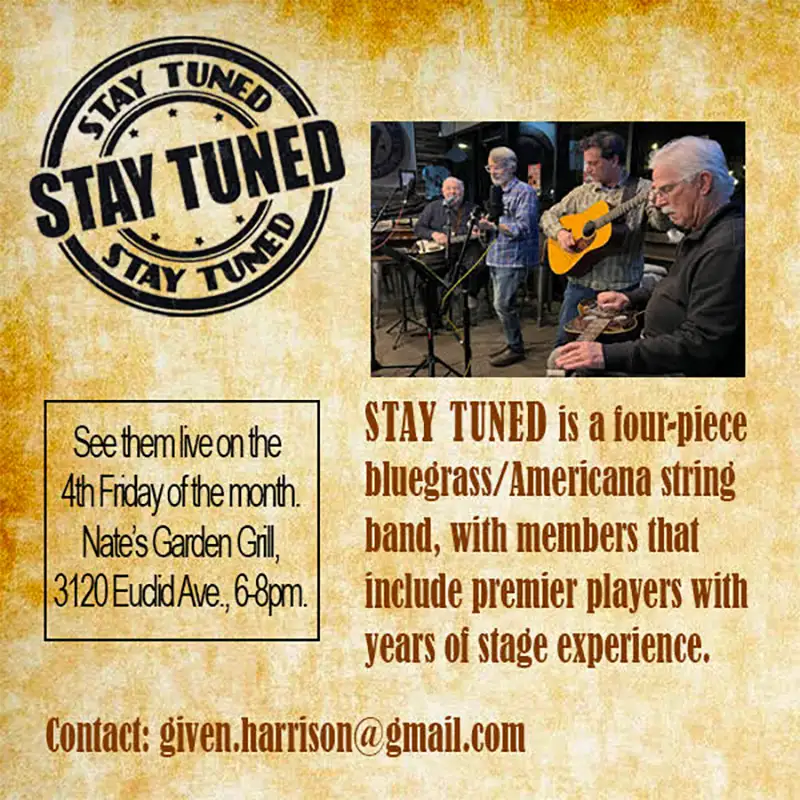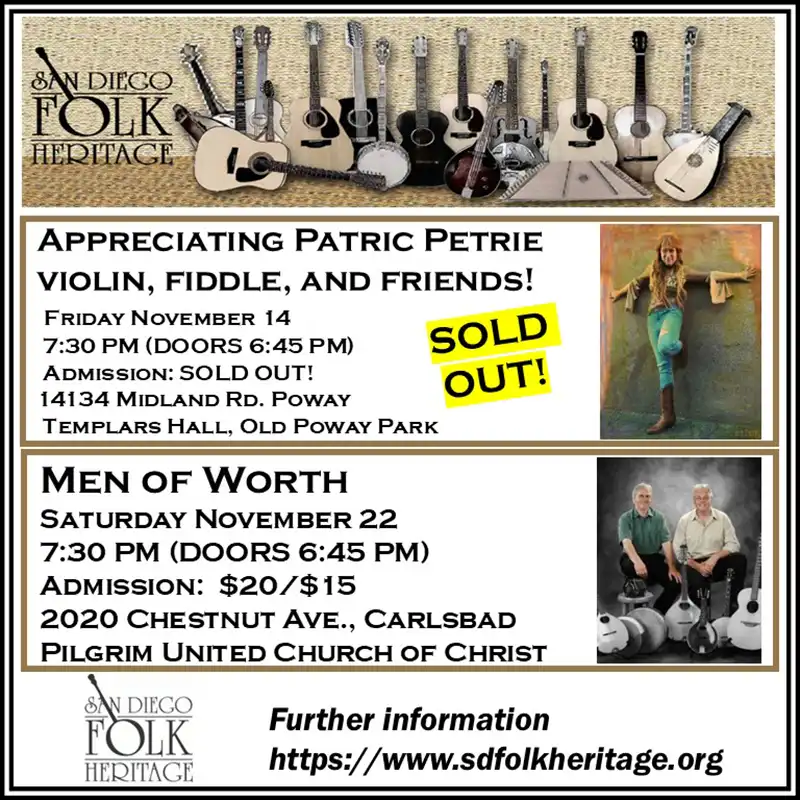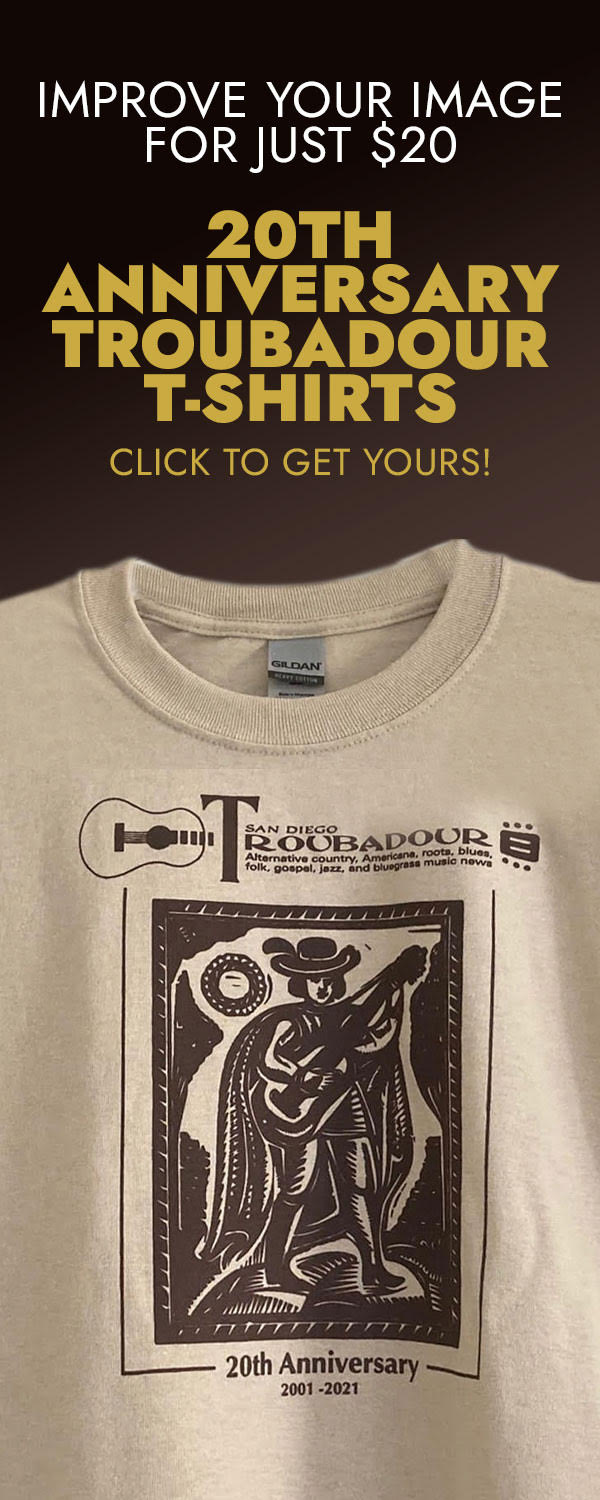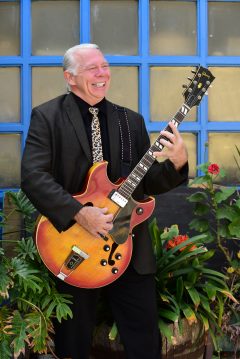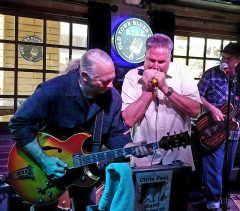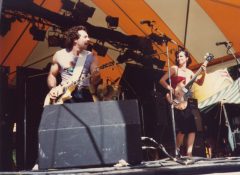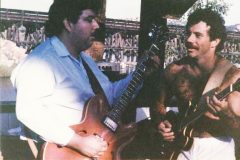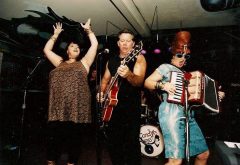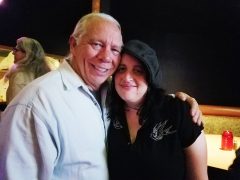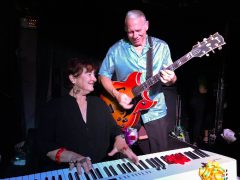Cover Story
Amplified and Electrified, Steve Wilcox Plugs In
“I’m so blessed,” Steve Wilcox says. “I’ve been blessed throughout my life as far as music goes.” You’d be hard pressed to argue the point. Widely regarded for his virtuosity on guitar, Wilcox has become a master of adaptability. His range of musical expertise encompasses a mixed bag of slow to raging blues, ’40s jump and big band swing. And the man seems just as comfortable rocking playbills of Americana and country roots as he is lighting off a “Cannonball”-style Texas boogie. Wilcox honed an extensive and eclectic skill set to a fine edge through most of the 1990s, touring the world with Candye Kane and the Swingin’ Armadillos.
Today, Wilcox contributes to multiple music projects around San Diego. You might catch him in the park with Sue Palmer’s Motel Swing Orchestra or ripping up sets of amplified Chicago harp-infused blues in the North County with his friend Chris Fast. Most recently, the guitarist’s work with Sue Palmer, Mercedes Moore, and Casey Hensley was recognized by the San Diego music community at this year’s SDMAs.
What most people don’t know about this San Diego native is that he hails from a family of electricians. Steve smiles proudly. “I’ve been a union electrician since 1972.” So, the real question here is how does a 45-year member of the International Brotherhood of Electrical Workers become one of Southern California’s premier guitarists? According to Wilcox the answer was found, like so many life-changing events, wedged beneath the windshield wipers of his mom’s car. It was a random, short-term offering that read “accordion and guitar lessons: 99¢.” Twelve-year-old Steve chose the latter.
With music roots so deep in San Diego, we started our conversation with family. “My mom played a little piano.” Steve says. “But my folks loved boogie woogie. That was their thing. I was raised with that kind of music in the house. Mostly 78s from the ’40s: Will Bradley; ‘Beat Me Daddy, Eight to the Bar’ was one of my favorite songs. That’s what I was raised on, that was ingrained. My dad loved all sorts of boogie woogie piano; piano was his favorite thing. When boogie woogie came on, he’d go nuts.” [laughing]
The impact on Wilcox was permanent. “I think I gravitated toward that boogie woogie style of piano.” He smiles and shakes his head. “I don’t know there’s something about that left hand, that groove that just drives me nuts. Even as a kid, ‘cause I was kid in the ’60s and music changed a lot! The advent of the rock edge–Hendrix, Cream. One of the things I did notice even though guitarists were pretty cool… I always liked the boogie woogie piano. That was something that was a constant through my whole life.”
So what drew you toward guitar? “It’s pretty funny, actually. I got my start on guitar at age twelve because I was shopping with my mom. We went to the Lucky Market, which was right off Home Avenue. We came out of the store and there was a flyer on the car. It was guitar or accordion lessons for 99 cents a lesson at a David Yantis music studio on Federal Blvd. I had already tried to learn trombone with not much success but when we went to the studio he had pictures of his students on the walls. I saw one of my buddies from sixth grade, Eddie Ruiz, sitting there holding his guitar. I looked at it and said, ‘Wow, Eddie’s cool so that’s what I want to do.’”
Were there any other influences outside of family… and Eddie Ruiz? “After David Yantis lessons in high school I had one friend that played guitar, Dave Hatherill. Dave was my best friend and was also a really good guitar player. Way better than me, but we didn’t play much together, it was more me watching him play. In addition to earning a Ph.D., Dave went on to be a very successful smooth jazz guitarist with several CDs to his credit.”
Where did your road turn toward the blues? “You know being a white kid in San Diego I wasn’t exposed to the really good black blues artists early on. I think James Harman said it best: ‘You don’t choose the blues, the blues chooses you.’ And I really agree with that because there’s something about the music that will get ya. In the ’70s, I remember I heard about this house party in Point Loma with the King Biscuit Blues Band. I parked the car a long way away and I could hear this music in the distance and it was just so good. Pretty soon I found myself running [laughing] to get there to check it out. And when I saw it, the place was just going off and they were just killing it. Paul Cowie was playing guitar, Ken Shoppmeyer was playing harp and I was just knocked out. What is this? Is it jazz? I didn’t know. But I became a fan. And I started following those guys around a little bit.”
So that’s when the blues chose you? “Even a little bit before that, in high school, when I first started learning guitar I was fooling around with it and I discovered my first blues lick. The beginning of ‘Bring It on Home.’ I remember thinking, ‘Man, this is Led Zeppelin and that was something I enjoyed listening to. And once I had something I enjoyed listening to, then I just kept playing and building on that one thing until I could do it.”
Talk a little about your first band. Steve laughs, “I was in a garage band with my cousin, Donnie Asbury. He played drums and I played guitar and the band was Donkey Don and the Imperials. We played parties with two guitars, bass, drums and a singer. Pete Grim fronted the band and we had a lot of fun.”
Donkey Don? “There’s a story behind that.” [laughing]
When did you feel that music would be your path in life? “I didn’t have any friends that really played music when I was growing up; it was surfing and stuff like that. My brother’s best friend, John Lusitana, had just started playing guitar and I showed him some things I had figured out and he took off with it. He was kind of a natural and he came back about a month later and said, ‘Look at this and this!’ That connection was really important to me because if it wasn’t for Johnny I don’t know if I would have kept playing guitar. And Johnny went on to become a founding member of Bratz, which later became Private Domain. Johnny would come over to my house and we’d have these Sunday afternoon jam sessions, just playing music and rockin’ out, working stuff out and having a blast.
“In 1977, Bratz played Dick’s at the Beach and the place was packed like usual and Johnny asked me if I wanted to sit in and play. And I said, ‘Yeah!’ So this was the first time that I played with a really good band and the first time I played on stage in a packed room and it was an exhilarating experience. And that pretty much got me hooked, right there. Plus, it was fun! We had the ‘juice’ from the crowd, and with Johnny it was like we rehearsed this every Sunday and I think that really started my journey.”
You play with so many different people, multiple bands, a wide range of genres and styles, how do you adapt so easily? “Well, everything from my point of view is blues based. And my approach to playing all of those styles is from a blues perspective. Jazz and blues are really close together and the swing style is really blues and melody-based as opposed to chops and licks. I’m a fan of melody and telling a story and that has always been in the back of my brain. When I first got started in my first serious band it was all blues. The band was called Hot and Glassy, this was when I lived in Hawaii back in 1980-81.”
Has your style of play changed over the years? “I’m becoming a more mature player. I’m old as dirt. [laughing] You just keep building on top of your repertoire and try to branch out and learn new things, exploring tonal qualities in the music and that helps you. Playing with Sue Palmer has really helped me a lot with that. If you take songs that have different changes in them… one thing blues guitar players do is they get stuck playing a pentatonic scale in a certain position and there’s nothing wrong with that. It’s really a good way to learn. It’s really based a bit on a major scale, all those notes are right there in that position. But if you expand that out on the guitar… and you’ve got changes, it’s pretty fun, you find those color tones and it helps you craft.”
Let’s talk about some of your musical friends…Wilcox corrects me. “Partners in crime? [laughing] Candye Kane. Oh, my God! It just makes me happy and sad at the same time. I mean, I’m so blessed; I’ve been so blessed throughout my life as far as music goes. I actually met Candye when I got married to Heather in ’87. We had a reception at the Full Moon, next door to the La Paloma Theater and we had the Paladins play. Well, Candye had started dating Thomas [Yearsley] and she came to that and she and Heather became good friends. At the time Candye was making a change from country music to blues because Thomas turned her onto all this great blues stuff. And she just dove right into that.
“In the early ’90s, I was playing with Ruby and the Red Hots, and Candye started putting these bands together. As fate would have it I’d left Ruby’s band and was off and needed to find something to do. I got a call from Candye on a Thursday asking if I wanted to play a gig with her at the Belly Up on Sunday? And I said, ‘Yeah, sure I’d love too!’ On Friday I went and picked up a tape. On Saturday I learned 15 songs and on Sunday I went to the Belly Up to play happy hour. It was Candye Kane, Sue Palmer, Greg Willis on bass, Robert Labbe on drums, and Chris Klich on saxophone. And we got up and had this raw energy that was undeniable and that was the start of Candye Kane and the Swingin’ Armadillos.
“I think about 30 days after that Belly Up gig we did a half-live, half-studio recording at the Belly Up. We put out her first tape called Burlesque Swing, a bunch of double entendre songs which was all Candye in the day. She shopped that tape and that got us a gig on the East Coast for the High on the Hog Festival. It also got her the first record deal with Antone’s Records in Austin. We also did SXSW.”
Since you mentioned her, what about Sue Palmer? “I’ve known Sue probably close to 30 years.” Steve says. “In the ’80s I was playing with Ruby at Patrick’s II and Sue’s band, Tobacco Road, played at Croce’s Top Hat. On breaks we’d step out into the little alley behind Patrick’s to get air and watch Tobacco Road and they’d do the same thing. Sue and I really clicked. I was raised on boogie woogie, so getting to play with, hang out, and tour the world with the Queen of Boogie Woogie was great! We had a blast! And still do for that matter. It’s fun as hell! Of all the things I’ve done in life, there are very few things that equate to the feeling you get making music with friends and the people you love.”
Sue Palmer had this to say: “Steve and I have been friends and musicians together since the ’80s. We have always loved playing with each other–he loves boogie woogie and has so much joie de vivre, it’s hard for me to resist playing with him! We ended up touring with Candye all over the world, and are still playing together. Steve loves to play and has the strength and motivation to wow the audiences, no matter how long the gig is–everyone calls on him at the end of a set because he’s just getting warmed up! He’s very athletic and used to jump from the stage to the tops of tables, not missing a beat. Now that he has a wireless guitar, who knows what will happen?!
–xoxo s.
What about Jonny Viau? “In the early ’70s I hired King Biscuit to play my 21st birthday. I rented a hall, and had a gigantic keg party. That’s how I met Paul Cowie and started taking guitar lessons from him. Now, fast forward a little bit, I had acquired a Mesa Boogie amplifier in the late ’70s and Paul wanted to try it in the studio. I went to the studio and there’s Jonny Viau. That was the cool thing about that time, there was a lot of stuff happening in San Diego, but King Biscuit had a set date at the Mandolin Wind on Thursday, Friday, and Saturday nights and you could always count on a great time when going there. The band was always good.”
And Laura Chavez? “Laura! Talk about people with natural ability! After I left Candye’s band in the late ’90s, she had other guitar players that came in: Jeff Ross and Heine Andersen, a slew of guitarists. But then Laura Chavez came in and she played a couple of tracks on Candye’s recordings and I got to know her through that. What really got me about Laura’s playing; I had to sub for her one time. Candye had a show in San Diego and Laura was in Europe and she asked me if I could do it. I said, ‘Yeah, I’d played with Candye a long time, I’d love to.’ Because I hadn’t played with her for awhile, she was playing all new material so I had to learn how Laura did it. I really had to dig into her music and her style and the more I did the more in awe I was of her playing. I was just knocked out. There aren’t a lot of people around nowadays that you can say are really original artists, especially in blues because people are always an offshoot of this person or that person. But Laura’s approach is one of the most original approaches I’ve heard in a long time.”
Didn’t you play with Michael Mann, aka Hollywood Fats, back in the day? “I moved to Hawaii and lived there from 1980 to 1983. In ’83 I moved back to San Diego and when I got back it was like I’d been gone for years. Nobody knew who the hell I was, so I went to the Mandolin Wind. And I saw Eric Lieberman and he said, ‘You should come up to Pancho’s on Sunday. It’s in Del Mar and I’ve got a band and you can sit in and play a little bit.’ I had in the back of my mind an old dive bar, dark and dingy with a blues band playing on a Sunday afternoon and not too many people. So I walk in the door, and it was the old Albatross restaurant; it’s really bright inside, windows all around, wide open and lots of people. It’s spring time and there are girls in bathing suit tops who had just come from the beach… so I walk in the place and it’s packed, I mean it’s packed! I’m just looking at this going, ‘Oh, my God!’ I’m looking up at the bandstand, and Big Tom Moore, this tall, thin blond guy wearing sunglasses with a harmonica and mic in one hand and the band is playing a Chicago groove, a shuffle, right? And, all of sudden, I hear these horns and they’re out on the patio and they start playing this lick and they start working their way through the crowd, ‘Bada, bada, bahhh.’ They weave their way through and make it up to the bandstand. Tom jumps into the song and I’m like, ‘Oh, I’m here!’ That was my every Sunday religious holiday… that was religion for me. It was 1983 through 1985.
“On one of those Sunday afternoons I ran into a keyboard player, Dave Camp, who played with the Hurricanes. He goes, ‘Hey man, I’m gonna’ run down to the Elephant Bar and see the James Harman Band.’ They had two guitar players, Kid Ramos and Hollywood Fats. I first heard Hollywood Fats in the mid-’70s at the La Paloma Theater. The Hollywood Fats Band opened for Dave Mason. It was Al Blake, Fred Kaplan, and Fats, and they were playing a lot of country blues. At that time I wasn’t really into country blues; I was more into Freddie King, faster Chicago-style, hard-driving, up-tempo stuff. But the name Hollywood Fats kinda stuck in the back of my head. As fate had it, Freddie King played there a month or two later and the Hollywood Fats Band opened up for him. I was a total Freddie King nut. This time the Fats band had added Richard Innes on drums and Larry Taylor on bass. So now you had the complete Fats band, and they are just kicking ass! Then Freddie did his show and he was Freddie… on fire! Then Freddie called Fats up to play guitar with him. So here you’ve got the MAN and the protégé: Fats. And every time Freddie would play a lick, Fats would play it back to him. Trading licks back and forth. I was just knocked out by that and it cemented Hollywood Fats in my mind. Fast forward back to this day at Pancho’s, and he told me Hollywood Fats is in that band…I’m THERE!
“I go into the Elephant Bar and head into the bathroom. As I push the door open I’m face to face with Fats. So, I probably told him that same story right then and how great it was to meet him. He was super nice, open and so generous with his time. When he got up to play with Kid Ramos, and when I heard that band I was blown away. Over the course of a few months Tom Moore would bring Fats, Kid, James Harman, Junior Watson, and these cats down to sit in with him on these Sunday afternoon shows at Pancho’s. And that’s when everything went crazy for me.
“I remember I was at the Belly Up; I think Harman was playing and Fats was there. I was talking with him; I guess I had the right amount of beers. [laughing] I went up to him and said, ‘Hey Fats, do you teach? You learned from Freddie and Muddy and all these guys, do you teach?’ He goes, ‘Yeah, I teach.’ So I got his number and I called him up and set a date and I drove to L.A. to meet up with him. I was only going to get a half hour or an hour lesson from him. And we ended up there for a couple of hours and he was showing me all this stuff. When I first got there he was listening to some old B.B. King from the Federal label and I think the one song he played for me was called ‘Boogie Rock’ aka ‘House Rock’ or something like that. He was showing me these diminished runs on the guitar that B.B. plays and I had never heard B.B. play like that. I was knocked out. He played it, then he showed me, and I learned from that point on the difference between rock blues and blues the way it should be played, traditionally. It had a lot to do with the equipment you use; your approach, your style, and learning all of this from Fats completely changed my life. There is not a time when I don’t pick up a guitar and play that I don’t think of Fats. And I don’t know if I told you this, but when my son was born in 1988, we named him Devin Michael Mann Wilcox.”
Any recording in your future? “Yes, I’m working on something I started about ten years ago [laughing] and then I ran out of money. It’s kind of a Steve Wilcox and Friends. I’ve got a few songs in the can; I’ve just got to finish it.”
Craziest bar or club story? “A Norwegian named Morten walks into a bar wearing a thong…”




